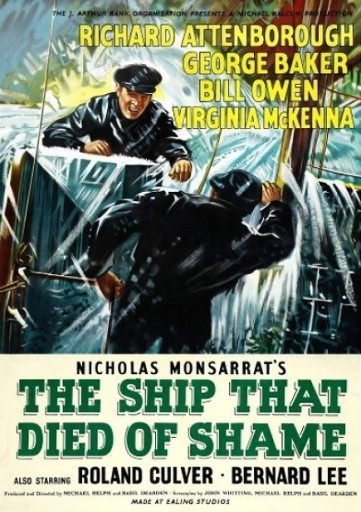Really good film this one.I never saw it on the big screen sadly but a number of years ago on TV. It is a good story – as you know it would be from the pen of Nicholas Monsarrat – and well filmed with a cast of top British Actors. Richard Attenborough plays the heartless – and merciless – character who along with his pal from wartime days gets into smuggling – and worse.
George Baker is the good man here, his friend, who in the end just can’t take what is happening.
People these days when thinking of George Baker would come up Inspector Wexford or another TV role but I think of him first in the swashbuckling ‘The Moonraker’ and then in this one – The Ship That Died of Shame
The cast includes such actors as Virginia McKenna, Bernard Lee, and Roland Culver
The Storyline is concerned with the ship of the title 1087 which is a British Royal Navy motor gun boat that has faithfully seen its crew through the worst that World War II can throw at them and it has been a proud and heroic ship. After the end of the war, George Hoskins (Richard Attenborough) convinces former skipper Bill Randall (George Baker) and Birdie (Bill Owen) to buy their beloved boat and use it for some harmless, minor smuggling of black market items like wine.
They find themselves transporting ever more sinister cargoes – mainly because of the greed of Richard Attenborough – counterfeit currency and weapons. Their beloved faithful craft had been utterly reliable and never let them down in wartime, but as if troubled by the work it is now doing, it begins to break down , as if ashamed of its current use. The crew revolt when they are used in the escape of a child murderer. At the close of the film George Baker realises that the ship just has had enough and realises she is dying of shame.
Above – Bernard Lee ‘smells a rat’
This film is based on a Nicholas Monsarrat short story. It is brilliantly crafted and plots the downfall of two men – and the ship that served them faithfully through WWII. The logic of the tale is that the ship itself is so ashamed of the terrible things it is made to do that it “dies” despite the hard-headed sailor’s belief that this is impossible.
Earlier in 1955 (April, in fact), another of Ealing’s fascinating final films – the genre hybrid The Ship That Died of Shame – hit British screens. The ship in question is actually a Royal Navy motor gun boat. These were small, fast vessels, equipped with a mix of guns and big enough to carry a crew of up to 30 men. The Ship That Died of Shame follows the life of one boat, MGB1087, starting from the peak of its wartime glory, through to its postwar inactivity and its rebirth in a new role: a pattern that parallels the lives of its crew.

In a performance that compares well with his crazed delinquent, Pinky, in Brighton Rock (1947), Richard Attenborough gets his teeth into the role of 1087’s spivvish ‘number one’, George Hoskins. A star first mate, whose quick thinking and opportunistic instincts served him well in military life, Hoskins persuades his old skipper, Bill Randall (George Baker), to rescue their derelict former boat. They intend to fill a gap in the black market, pitched by Hoskins as a necessary and almost benevolent activity in a ration-weary Britain.
It’s here that The Ship That Died of Shame parts company with other British war movies, taking a sudden nosedive into murkier waters. The producer/director team of Michael Relph and Basil Dearden navigate into thriller territory as rival gangs, a nervous crew, the port authority and other parties with a stake in postwar dignity – including the boat herself – react to Hoskins and Randall’s new enterprise.

Mixing genres – war, crime, the supernatural – is a risky strategy, but it pays off here. The Ship That Died of Shame opposes the war film’s proud sense of propriety with the deviant cynicism of the crime film. In contrast with the optimism of many of Ealing’s postwar films – with their crowds pulling together; their defence of small communities against outsized corporations; the dreamlike vision of a new Britain forged in history but emboldened by progressive ambition – The Ship That Died of Shame reveals a darker side to the golden years of postwar reconstruction.
Who’d have thought that the studio that gave us the giddy celebrations of George Formby, Passport to Pimlico (1949) and The Titfield Thunderbolt (1953) could sober us up with this tale of the sour taste of victory?


… [Trackback]
[…] Read More here on that Topic: filmsofthefifties.com/the-ship-that-died-of-shame/ […]